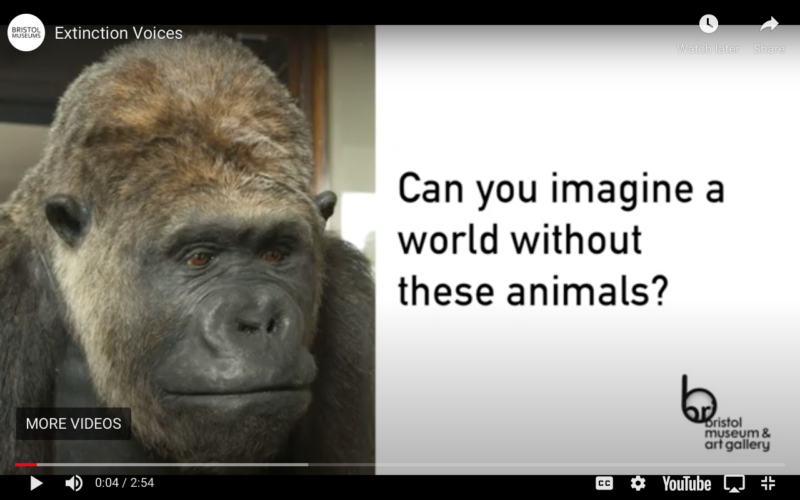Maureen La Frenais responds to a workshop: Using Natural Science Collections to Challenge the Climate Emergency as part of the South West Fed’s 2020 conference.
A great topic, enthralling and I learned so much from this first workshop. With four case studies, and five speakers in 20 minutes it was certainly no mean feat, timed to perfection. Highlighting Bristol and Plymouth projects and research we were reminded that despite Covid 19, and Brexit, and the ongoing political scenario of Trump and Boris – we are still in an ecological emergency.
Climate change is putting one million species at risk and over 50 countries are actively working to try and reverse this catastrophic loss of diversity.
We heard of an engaging and recent exhibition at Bristol Museum and Art Gallery, that captured media attention and directly challenged visitors ‘Can you imagine a world without these animals?’. Its innovative and immensely powerful approach displayed 30 animals covered with black veils. No longer on view these were maybe favourite animals for some people, and a bit of a shock tactic to realise that they were vulnerable, endangered and could possibly become extinct. In London, at the Horniman Museum, plastics were put into the aquariums. These relatively low-cost solutions and ‘brave out the box creativity’ were great examples to deliver a strong ‘call to action’ to visitors.
What can be done at a local level in your museum?
Well, appreciate your collection and move on from the idea that objects killed and stuck with pins have no value. Researchers are constantly finding out more and if they don’t know what you have then it can’t be researched. Today, the Butterfly Conservation is leading the way for many new colonisations of moths around Bristol and Bath and throughout the UK. Even a collection badly eaten by pests may still have informative labels that identify locations that once suited these moths. Being able to access global biodiversity information is essential.
So, there’s even further benefits to knowing your natural science collection.
Analytical techniques have improved vastly and are far less invasive in the way samples are taken from specimens. DNA from the pins can sometimes work as well, even clumps of moss may not look like much, but they can tell us a lot. Importantly, historic collections can even influence new regulations and policies for procedures and collectors today. Information from the past can inform the future and ultimately be for the good in the fight against climate change.
Make a choice to review your natural science collection and specimens that have been relegated to drawers and cupboards in the most inaccessible storage rooms, or on display in the least visited areas
Museums are spaces to have conversations about the climate emergency. The clear and simple message is to shift thinking and gain more emotional connection in the narrative and in the display. And finally, this is a great comment from Jan Freedman at The Box in Plymouth
‘All of us might be looking after dead things, but the research they offer makes them so much more alive.’
Make sure that you … shout, blog, tweet and make use of social media to let others know about those amazing objects in your care.
Writer: Maureen La Frenais
Arts and Heritage Consultant.
Waking the Giant
Maureen is currently a trustee for SWfed and lives Dorset. Her career path in graphic design and illustration kick-started with Brecon Beacons National Park, then took a short diversion as a medical artist at Guy’s hospital. For over 30 years she has worked for councils, and charities including RNLI, National Trust, English Heritage and many museums. Her work and projects usually link to heritage and interpretation and more recently integrate art, wellbeing and the environment. As artist she is a member of Poole Printmakers and fortunate to share studio spare in Poole …by the sea and close to the Jurassic Coast!
Lead image taken from Bristol Museum and Art Gallery: Extinction Voice
@SWfed
@HelenaCDO
@swmuseums
@isla_gladstone
@bristolmuseum
@theboxplymouth
@BristolUni
@Nat_SCA
@OriginalGCG
#ExtinctionVoices


